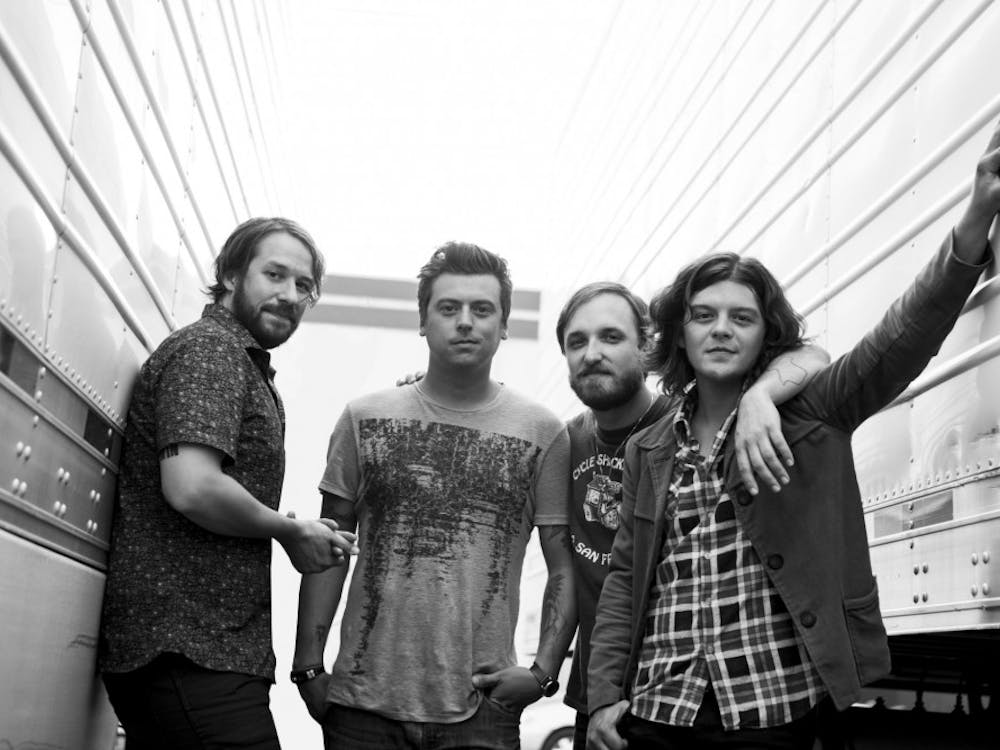Art on campus ranges from the broadly familiar to the diamonds in the rough
By Melissa Nip
One day during lunch, University President Rev. E. William Beauchamp expressed to Dr. Thomas Greene, dean of the graduate school, his desire to see a certain faded and rusted sculpture on campus repainted. The sculpture is a red steel sculpture and sits by Buckley Center near the greenhouse entrance. Greene made sure this wish was honored.
He consulted the President on the color and went out and bought the paint. With the help of the physical plant team, the sculpture was given a fresh new coat of paint.
"Caring for what we have is good stewardship; it's that simple," Greene said. "Restoring the piece to its original color also enhances the sculpture and the beauty of our great campus."
The repainted steel sculpture is entitled "Papa Sierra" and was constructed in 1980 by Tom Morandi. It was selected from a huge art exhibit that showcased the work of ten sculptors in April 1980.
This sculpture is one of the many sculptures on campus that offer artistic expression.
The Christ the Teacher statue is one of the more noticeable sculptures on campus and sits between Franz Hall and Mago Hunt Center. Performing and fine arts professor Jill Hoddick was on a committee in 1989 that was given the task of searching for an artist that would create an original sculpture for the UP campus. The committee was lead by professor Mary Margaret, a former fine arts professor and comprised eight faculty members and staff.
The artist Donovan Peterson was chosen and it took him about four years to actually complete the sculpture. The University President at the time, President Thomas Oddo, was very supportive of the piece but died in 1989 before he was able to see it brought to campus.
"The Christ the Teacher statue was a memorial to our University President Thomas Oddo," Dr. Michael Connolly, performing and fine arts professor, said. "He was much beloved by students."
The sculpture was installed and dedicated to the President in 1995.
"The sculptures arrived on a truck," Connolly said. "They enlisted the baseball team to lift them."
The sculptures are made of cast bronze and are thirty percent larger than the normal human size. The floor under the sculptures is made of stones called basalt that are indigenous to the Holy Lands. The artist called his work "figurative abstraction," which is a blend of both representational and abstract components.
"The figures have a universal quality," Hoddick said. "No definitive race, but human- every man figures."
There are other elements of the sculpture that passer-byers wouldn't normally notice. The negatives or spaces between the figures were thought out by the artist and work into the piece as a whole. The baby in the piece was modeled after Peterson's son.
Since its installment, the sculpture has been more than just aesthetically pleasing to students and faculty on campus.
"I think it is a perfect sculpture for our campus community,"
Hoddick said. "It reminds us of the religious nature of the campus, our interest in educating the whole human being, and sharing our gifts with others."
The doors and front columns of the Chapel of Christ the Teacher are another example of the fusion between art and religion. The doors and columns were sculpted by LeRoy Setziol out of solid black walnut in 1986. Religious symbols can be seen in the intricate carvings in the door.
"The lines of the sun's rays all converge into the handle," Connolly said. "And there are symbols of the life of Jesus like an ear of corn, snail and whale."
The door also has images that represent the four gospels. A man represents the book of Matthew, a lion represents Mark, an ox represents Luke and an eagle represents John. In addition, the four columns represent the four gospels.
LeRoy Setziol also completed wooden sculpture found within the lobby of Mago Hunt Center. It is 12 carved wood pieces made of Alaskan yellow cedar from the floor to the ceiling, resembling a totem pole. It was built in 1978 and is entitled the "Paul E. Ouellette Memorial Wood Sculpture."
A sculpture that marks the University of Portland as a part of history would be the Captain William Clark Monument. The Clark Monument stands proudly at the edge of the bluff and serves as a symbol of exploration and discovery. The monument depicts three men, William Clark, York, Clark's black slave, and an unnamed American Indian who was a member of the Cushook tribe.
The statue stands at the southernmost point of the Willamette River Valley, which, according to legend, is the area that Clark and his men first sighted a distant mountain, which Clark later named Mt. Jefferson.
"There is a marker on the ground in front of the sculpture that points to Mt. Hood and Mt. Jefferson," Connolly said.
According to Connolly, this is also where Clark saw the Willamette River and realized that it was a separate river from the Columbia River.
"They learned about the Willamette from native people out east by the Sandy River, where Troutdale is now," Connolly said. "Clark came back overland and saw it from somewhere on the bluff, at or near our campus."
The sculpture is cast in bronze, stands six feet and nine inches tall, and stands on a four foot concrete and stone base. Clark is seen pointing toward the mountain with his right hand, while holding his journal in his left. He is taking a step forward, both figuratively and metaphorically. Clark's windblown coat reveals four ermine tails given to him by Sacagawea as a Christmas gift in 1805.
York, Clark's slave, is shown holding Clark's left hand and pressing his right hand against Clark's shoulder, as a sign of support and friendship. The Cushook Indian is seen holding a wapato plant, symbolizing the Cushook heritage.
The monument was created by sculptor and muralist Michael Florin Dente in 1986. He had private collections in various places other than the Northwest such as New York City, Florence, Rome, Italy and Saudi Arabia. He also was a faculty member of the Department of Fine Arts at UP until 2000.
Hoddick believes that art plays a very significant role on campus and hopes that students will realize this as well.
"I hope students will open their eyes to their surroundings," Hoddick said. "This is a place of education and learning and what better way to learn about art than to look at it up close and personal."
Connolly sees art as something that adds vitality and beauty to our lives when it can sometimes seem repetitive.
"When you look at something beautiful it can take you out of the mundane," Connolly said. "There are things much bigger than the day to day grind."







